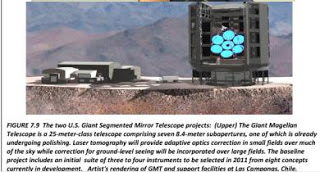Ad Support : Nano Technology Netbook Technology News Computer Software
An extremely large telescope (ELT) is a class of telescope with an aperture of more than 20 m diameter when discussing reflecting telescopes of optical wavelengths including UV, Visible, and Near infrared wavelengths. Among many planned capabilities, ELTs are planned to increase the chance of finding earth-like planets around other stars.
The Giant Magellan Telescope (GMT) is a ground-based extremely large telescope planned for completion in 2018. It will consist of seven 8.4 m (27.6 ft) diameter primary segments, with the resolving power of a 24.5 m (80.4 ft) primary mirror and collecting area equivalent to 21.4 m (70.2 ft) one. The telescope is expected to have over four times the light-gathering ability of existing instruments.

The Thirty Meter Telescope (TMT) will be a ground-based astronomical observatory with a 30-meter (98-foot) diameter segmented mirror capable of observations from the near-ultraviolet to the mid-infrared (0.31 to 28 μm). An adaptive optics system will correct for image blur caused by the atmosphere of the Earth. At wavelengths longer than 0.8 μm, this correction will enable observations with ten times the spatial resolution of the Hubble Space Telescope. TMT will be more sensitive than existing ground-based telescopes by factors of 10 (natural seeing mode) to 100 (adaptive optics mode). If completed on schedule, TMT will be the first of the new generation of Extremely Large Telescopes. The Telescope cost is currently estimated to be $970 million.
The European Extremely Large Telescope
The European Extremely Large Telescope (E-ELT) will be a ground-based astronomical observatory with a 42-meter diameter segmented mirror. The construction period is estimated to be 7–8 years leading to first light around 2018.
The Large Synoptic Survey Telescope is a revolutionary facility which will produce an unprecedented wide-field astronomical survey of our universe using an 8.4-meter ground-based telescope. The LSST leverages innovative technology in all subsystems: the camera (3200 Megapixels, the world’s largest digital camera), telescope (simultaneous casting of the primary and tertiary mirrors; two aspherical optical surfaces on one substrate), and data management (30 Terabytes of data nightly, nearly instant alerts issued for objects that change in position or brightness)
The LSST is scheduled to see first light in 2014, to begin doing science in 2015 and be in full survey operations by 2016. While we await initiation of construction funding, those dates remain estimates. In addition to successful reviews by funding agencies, significant milestones have already been reached, including the casting of the primary and tertiary mirrors.
If you liked this article, please give it a quick review on Reddit, or StumbleUpon. Thanks
Supporting Advertising
Business Success
How to Make Money
Executive Jobs
Paid Surveys
Thank You

Brian Wang is a Futurist Thought Leader and a popular Science blogger with 1 million readers per month. His blog Nextbigfuture.com is ranked #1 Science News Blog. It covers many disruptive technology and trends including Space, Robotics, Artificial Intelligence, Medicine, Anti-aging Biotechnology, and Nanotechnology.
Known for identifying cutting edge technologies, he is currently a Co-Founder of a startup and fundraiser for high potential early-stage companies. He is the Head of Research for Allocations for deep technology investments and an Angel Investor at Space Angels.
A frequent speaker at corporations, he has been a TEDx speaker, a Singularity University speaker and guest at numerous interviews for radio and podcasts. He is open to public speaking and advising engagements.



